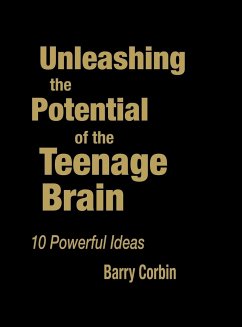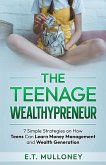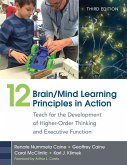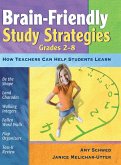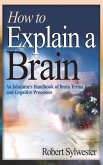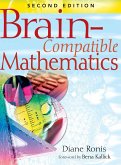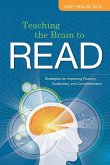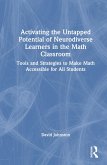- Gebundenes Buch
- Merkliste
- Auf die Merkliste
- Bewerten Bewerten
- Teilen
- Produkt teilen
- Produkterinnerung
- Produkterinnerung
Provides teachers with specific guidelines to establish an optimal learning environment for teenagers and offers case studies that illustrate how to translate theory into workable classroom practice.
Andere Kunden interessierten sich auch für
![The Teenage Wealthypreneur The Teenage Wealthypreneur]() E. T. MulloneyThe Teenage Wealthypreneur21,99 €
E. T. MulloneyThe Teenage Wealthypreneur21,99 €![12 Brain/Mind Learning Principles in Action 12 Brain/Mind Learning Principles in Action]() Renate Nummela Caine12 Brain/Mind Learning Principles in Action40,99 €
Renate Nummela Caine12 Brain/Mind Learning Principles in Action40,99 €![Brain-Friendly Study Strategies, Grades 2-8 Brain-Friendly Study Strategies, Grades 2-8]() Amy SchwedBrain-Friendly Study Strategies, Grades 2-884,99 €
Amy SchwedBrain-Friendly Study Strategies, Grades 2-884,99 €![How to Explain a Brain How to Explain a Brain]() Robert SylwesterHow to Explain a Brain71,99 €
Robert SylwesterHow to Explain a Brain71,99 €![Brain-Compatible Mathematics Brain-Compatible Mathematics]() Diane RonisBrain-Compatible Mathematics78,99 €
Diane RonisBrain-Compatible Mathematics78,99 €![Teaching the Brain to Read Teaching the Brain to Read]() Judy WillisTeaching the Brain to Read33,99 €
Judy WillisTeaching the Brain to Read33,99 €![Activating the Untapped Potential of Neurodiverse Learners in the Math Classroom Activating the Untapped Potential of Neurodiverse Learners in the Math Classroom]() David JohnstonActivating the Untapped Potential of Neurodiverse Learners in the Math Classroom185,99 €
David JohnstonActivating the Untapped Potential of Neurodiverse Learners in the Math Classroom185,99 €-
-
-
Provides teachers with specific guidelines to establish an optimal learning environment for teenagers and offers case studies that illustrate how to translate theory into workable classroom practice.
Hinweis: Dieser Artikel kann nur an eine deutsche Lieferadresse ausgeliefert werden.
Hinweis: Dieser Artikel kann nur an eine deutsche Lieferadresse ausgeliefert werden.
Produktdetails
- Produktdetails
- Verlag: Corwin
- Seitenzahl: 168
- Erscheinungstermin: 12. September 2007
- Englisch
- Abmessung: 286mm x 221mm x 14mm
- Gewicht: 699g
- ISBN-13: 9781412957625
- ISBN-10: 1412957621
- Artikelnr.: 22797426
- Herstellerkennzeichnung
- Libri GmbH
- Europaallee 1
- 36244 Bad Hersfeld
- gpsr@libri.de
- Verlag: Corwin
- Seitenzahl: 168
- Erscheinungstermin: 12. September 2007
- Englisch
- Abmessung: 286mm x 221mm x 14mm
- Gewicht: 699g
- ISBN-13: 9781412957625
- ISBN-10: 1412957621
- Artikelnr.: 22797426
- Herstellerkennzeichnung
- Libri GmbH
- Europaallee 1
- 36244 Bad Hersfeld
- gpsr@libri.de
Barry Corbin, M.Ed., is an educational consultant and part-time lecturer in the School of Education, Acadia University, Nova Scotia, Canada. He is recently retired from the Annapolis Valley Regional School Board, where he served for over 30 years as teacher, school administrator, curriculum and program consultant and staff developer. Barry has also served as consultant and advisor to several Department of Education initiatives for the province of Nova Scotia, Canada. In his last role with the AVRSB, he served as Youth Pathways and Transitions consultant where he was responsible for researching and developing alternate educational programs and pathways for under-achieving high school students. As an independent consultant, he frequently presents at professional development workshops and in-services on such topics as brain-compatible teaching and learning, multiple intelligences and learning styles, differentiated instruction, authentic assessment as well as collaborative/cooperative teaching strategies. His workshops are enthusiastically endorsed by those in attendance because he engages his audiences with many of the interactive strategies he advocates in his writing. Barry holds a Bachelor of Science degree (geology) from Acadia University, a Bachelor of Education from the same institution and a Master of Education in Curriculum Development from St. Mary's University in Halifax, Nova Scotia. He is the co-author of two high school social studies texts used in Atlantic Canada.
Acknowledgments About the Author Part I. Discovering the Teenage Brain 1. Introduction: The Creatures in the Classroom! Those Exasperating and Unfathomable Teenagers How Do We Reach and Teach Those Unpredictable Teenage Brains? Wanted: A New Approach to Teaching Teenagers! Why Educators Need to Learn About the Teenage Brain Brain-Compatible Teaching and the New Science of Learning The Emergence of a New Pedagogical Model 2. Adolescence and the Teenage Brain--What Is Different and How Do We Know? Adolescence--Just the Quick Facts! The Teenage Brain--What We Had Believed How Neuroscience and Medical Technology Are Changing Our Ideas About the Teenage Brain The Future of Brain Imaging 3. Big Changes in the Teenage Brain: What We Have Learned and Are Learning The Teenage Brain--A Work in Progress From Back to Front: Brain Growth, Neuron Proliferation and Pruning, Myelin Development What It All Means (We Think!) Looking Back at Part I : Reflection and Review Part II. Ten Powerful Ideas About the Brain and Learning and What It Means for Teaching the Teenage Brain 4. Powerful Idea #1: Constructing New Knowledge What Powerful Idea #1 Means for Teachers: Helping Teenagers Construct Personal Meaning How It Might Look--A Case Study: "Saving the Old Victoria Street School" Constructivist Teaching Strategies 5. Powerful Idea #2: Different Ways of Learning Being Smart-- Human Intelligence Preferred Ways of Learning--Our Learning Styles What Powerful Idea #2 Means for Teachers: Teaching to Each Unique Brain Unleashing the Potential of the Teenage Brain: Six Things You Ought to Do How It Might Look--A Case Study: "Ms. Taylor
s Meteorology Unit" 6. Powerful Idea #3: Making Meaning, Connections, and Patterns What Powerful Idea #3 Means for Teachers: Developing Pattern Making and Detecting Abilities Some Strategies for You to Consider How It Might Look--A Case Study: "Mrs. Parasiuk
s Poetry Class" 7. Powerful Idea #4: Whole-Brain Learning Left, Right, or Both Brains? What Powerful Idea #4 Means for Teachers: Effective Ways to Make Your Classroom Teaching Whole Brain How It Might Look--A Case Study: "Whole-Brain Assessment in Mr. Amos
Horticulture Class" 8. Powerful Idea #5: Multiple Memory Pathways Different Kinds of Memory--Declarative Versus Procedural Learning and Memory What Powerful Idea #5 Means for Teachers: Using Multiple Memory Pathways How It Might Look--A Case Study: "Mrs. Singh
s Musical Science" 9. Powerful Idea #6: Physical Activity and Movement Exercise For the Brain What Powerful Idea #6 Means for Teachers: Utilizing Physical Activity to Enhance Learning How It Might Look--A Case Study: "Kinesthetic Learning in High School Biology" 10. Powerful Idea #7: Memory, Learning, and Emotion Too Much or Too Little? The Impact of High Stress and Threat Brain Attention and Focus Motivation and Engagement What Powerful Idea #7 Means for Teachers: Managing the Emotional Environment of the Classroom How It Might Look--A Case Study: "The Affirmative Mr. Hawkes" 11. Powerful Idea #8: Reflection and Self-Assessment Knowing Oneself Reflection Metacognition What Powerful Idea #8 Means for Teachers: Developing Reflective Learners How It Might Look--A Case Study: "Feedback and Reflection in the Visual Arts Class" 12. Powerful Idea #9: Social Interaction and Learning What Powerful Idea #9 Means for Teachers: Providing for Social Interaction and Collaboration How It Might Look--A Case Study: "A Jigsaw Activity in High School Political History" 13. Powerful Idea #10: Time and Timing When Is the Best Time? An Optimal Time to Learn An Optimal Time Pattern for Learning The Optimal Times During the Learning Episode The Optimal Times During the Day What Powerful Idea #10 Means for Teachers: Taking Advantage of Time and Timing How It Might Look--A Case Study: "Mrs. Gregory
s Lesson Planning" Looking Back at Part II - Reflection and Review Part III. The Classroom Environment and What Teachers and Students Should Be Doing 14. The Learning Environment The Physical Environment The Socioemotional Environment The Intellectual Environment 15. The Brain-Compatible Teacher: Changing and Evolving Roles A Complex and Challenging Profession! The Teacher as Facilitator, Orchestrator, and Conductor The Teacher as Coach and Model The Teacher as Continuous Learner The Teacher as Monitor, Assessor, and Evaluator The Teacher as a Resource 16. Teenage Students: Higher Expectations and New Roles What We Want and Need From Our Teenage Students Looking Back at Part III - Reflection and Review Part IV. Now What? So What?-- Reflecting Upon What We Have Learned 17. What Does It All Mean? A Quick Review: The Important Things We Have Learned What Do We Need to Do to Help Teenagers Reach Their Potential? Some Final Thoughts: Opening Doorways to Possibilities Wanted: An Epidemic for an Idea Glossary Suggested Readings Bibliography Index
s Meteorology Unit" 6. Powerful Idea #3: Making Meaning, Connections, and Patterns What Powerful Idea #3 Means for Teachers: Developing Pattern Making and Detecting Abilities Some Strategies for You to Consider How It Might Look--A Case Study: "Mrs. Parasiuk
s Poetry Class" 7. Powerful Idea #4: Whole-Brain Learning Left, Right, or Both Brains? What Powerful Idea #4 Means for Teachers: Effective Ways to Make Your Classroom Teaching Whole Brain How It Might Look--A Case Study: "Whole-Brain Assessment in Mr. Amos
Horticulture Class" 8. Powerful Idea #5: Multiple Memory Pathways Different Kinds of Memory--Declarative Versus Procedural Learning and Memory What Powerful Idea #5 Means for Teachers: Using Multiple Memory Pathways How It Might Look--A Case Study: "Mrs. Singh
s Musical Science" 9. Powerful Idea #6: Physical Activity and Movement Exercise For the Brain What Powerful Idea #6 Means for Teachers: Utilizing Physical Activity to Enhance Learning How It Might Look--A Case Study: "Kinesthetic Learning in High School Biology" 10. Powerful Idea #7: Memory, Learning, and Emotion Too Much or Too Little? The Impact of High Stress and Threat Brain Attention and Focus Motivation and Engagement What Powerful Idea #7 Means for Teachers: Managing the Emotional Environment of the Classroom How It Might Look--A Case Study: "The Affirmative Mr. Hawkes" 11. Powerful Idea #8: Reflection and Self-Assessment Knowing Oneself Reflection Metacognition What Powerful Idea #8 Means for Teachers: Developing Reflective Learners How It Might Look--A Case Study: "Feedback and Reflection in the Visual Arts Class" 12. Powerful Idea #9: Social Interaction and Learning What Powerful Idea #9 Means for Teachers: Providing for Social Interaction and Collaboration How It Might Look--A Case Study: "A Jigsaw Activity in High School Political History" 13. Powerful Idea #10: Time and Timing When Is the Best Time? An Optimal Time to Learn An Optimal Time Pattern for Learning The Optimal Times During the Learning Episode The Optimal Times During the Day What Powerful Idea #10 Means for Teachers: Taking Advantage of Time and Timing How It Might Look--A Case Study: "Mrs. Gregory
s Lesson Planning" Looking Back at Part II - Reflection and Review Part III. The Classroom Environment and What Teachers and Students Should Be Doing 14. The Learning Environment The Physical Environment The Socioemotional Environment The Intellectual Environment 15. The Brain-Compatible Teacher: Changing and Evolving Roles A Complex and Challenging Profession! The Teacher as Facilitator, Orchestrator, and Conductor The Teacher as Coach and Model The Teacher as Continuous Learner The Teacher as Monitor, Assessor, and Evaluator The Teacher as a Resource 16. Teenage Students: Higher Expectations and New Roles What We Want and Need From Our Teenage Students Looking Back at Part III - Reflection and Review Part IV. Now What? So What?-- Reflecting Upon What We Have Learned 17. What Does It All Mean? A Quick Review: The Important Things We Have Learned What Do We Need to Do to Help Teenagers Reach Their Potential? Some Final Thoughts: Opening Doorways to Possibilities Wanted: An Epidemic for an Idea Glossary Suggested Readings Bibliography Index
Acknowledgments About the Author Part I. Discovering the Teenage Brain 1. Introduction: The Creatures in the Classroom! Those Exasperating and Unfathomable Teenagers How Do We Reach and Teach Those Unpredictable Teenage Brains? Wanted: A New Approach to Teaching Teenagers! Why Educators Need to Learn About the Teenage Brain Brain-Compatible Teaching and the New Science of Learning The Emergence of a New Pedagogical Model 2. Adolescence and the Teenage Brain--What Is Different and How Do We Know? Adolescence--Just the Quick Facts! The Teenage Brain--What We Had Believed How Neuroscience and Medical Technology Are Changing Our Ideas About the Teenage Brain The Future of Brain Imaging 3. Big Changes in the Teenage Brain: What We Have Learned and Are Learning The Teenage Brain--A Work in Progress From Back to Front: Brain Growth, Neuron Proliferation and Pruning, Myelin Development What It All Means (We Think!) Looking Back at Part I : Reflection and Review Part II. Ten Powerful Ideas About the Brain and Learning and What It Means for Teaching the Teenage Brain 4. Powerful Idea #1: Constructing New Knowledge What Powerful Idea #1 Means for Teachers: Helping Teenagers Construct Personal Meaning How It Might Look--A Case Study: "Saving the Old Victoria Street School" Constructivist Teaching Strategies 5. Powerful Idea #2: Different Ways of Learning Being Smart-- Human Intelligence Preferred Ways of Learning--Our Learning Styles What Powerful Idea #2 Means for Teachers: Teaching to Each Unique Brain Unleashing the Potential of the Teenage Brain: Six Things You Ought to Do How It Might Look--A Case Study: "Ms. Taylor
s Meteorology Unit" 6. Powerful Idea #3: Making Meaning, Connections, and Patterns What Powerful Idea #3 Means for Teachers: Developing Pattern Making and Detecting Abilities Some Strategies for You to Consider How It Might Look--A Case Study: "Mrs. Parasiuk
s Poetry Class" 7. Powerful Idea #4: Whole-Brain Learning Left, Right, or Both Brains? What Powerful Idea #4 Means for Teachers: Effective Ways to Make Your Classroom Teaching Whole Brain How It Might Look--A Case Study: "Whole-Brain Assessment in Mr. Amos
Horticulture Class" 8. Powerful Idea #5: Multiple Memory Pathways Different Kinds of Memory--Declarative Versus Procedural Learning and Memory What Powerful Idea #5 Means for Teachers: Using Multiple Memory Pathways How It Might Look--A Case Study: "Mrs. Singh
s Musical Science" 9. Powerful Idea #6: Physical Activity and Movement Exercise For the Brain What Powerful Idea #6 Means for Teachers: Utilizing Physical Activity to Enhance Learning How It Might Look--A Case Study: "Kinesthetic Learning in High School Biology" 10. Powerful Idea #7: Memory, Learning, and Emotion Too Much or Too Little? The Impact of High Stress and Threat Brain Attention and Focus Motivation and Engagement What Powerful Idea #7 Means for Teachers: Managing the Emotional Environment of the Classroom How It Might Look--A Case Study: "The Affirmative Mr. Hawkes" 11. Powerful Idea #8: Reflection and Self-Assessment Knowing Oneself Reflection Metacognition What Powerful Idea #8 Means for Teachers: Developing Reflective Learners How It Might Look--A Case Study: "Feedback and Reflection in the Visual Arts Class" 12. Powerful Idea #9: Social Interaction and Learning What Powerful Idea #9 Means for Teachers: Providing for Social Interaction and Collaboration How It Might Look--A Case Study: "A Jigsaw Activity in High School Political History" 13. Powerful Idea #10: Time and Timing When Is the Best Time? An Optimal Time to Learn An Optimal Time Pattern for Learning The Optimal Times During the Learning Episode The Optimal Times During the Day What Powerful Idea #10 Means for Teachers: Taking Advantage of Time and Timing How It Might Look--A Case Study: "Mrs. Gregory
s Lesson Planning" Looking Back at Part II - Reflection and Review Part III. The Classroom Environment and What Teachers and Students Should Be Doing 14. The Learning Environment The Physical Environment The Socioemotional Environment The Intellectual Environment 15. The Brain-Compatible Teacher: Changing and Evolving Roles A Complex and Challenging Profession! The Teacher as Facilitator, Orchestrator, and Conductor The Teacher as Coach and Model The Teacher as Continuous Learner The Teacher as Monitor, Assessor, and Evaluator The Teacher as a Resource 16. Teenage Students: Higher Expectations and New Roles What We Want and Need From Our Teenage Students Looking Back at Part III - Reflection and Review Part IV. Now What? So What?-- Reflecting Upon What We Have Learned 17. What Does It All Mean? A Quick Review: The Important Things We Have Learned What Do We Need to Do to Help Teenagers Reach Their Potential? Some Final Thoughts: Opening Doorways to Possibilities Wanted: An Epidemic for an Idea Glossary Suggested Readings Bibliography Index
s Meteorology Unit" 6. Powerful Idea #3: Making Meaning, Connections, and Patterns What Powerful Idea #3 Means for Teachers: Developing Pattern Making and Detecting Abilities Some Strategies for You to Consider How It Might Look--A Case Study: "Mrs. Parasiuk
s Poetry Class" 7. Powerful Idea #4: Whole-Brain Learning Left, Right, or Both Brains? What Powerful Idea #4 Means for Teachers: Effective Ways to Make Your Classroom Teaching Whole Brain How It Might Look--A Case Study: "Whole-Brain Assessment in Mr. Amos
Horticulture Class" 8. Powerful Idea #5: Multiple Memory Pathways Different Kinds of Memory--Declarative Versus Procedural Learning and Memory What Powerful Idea #5 Means for Teachers: Using Multiple Memory Pathways How It Might Look--A Case Study: "Mrs. Singh
s Musical Science" 9. Powerful Idea #6: Physical Activity and Movement Exercise For the Brain What Powerful Idea #6 Means for Teachers: Utilizing Physical Activity to Enhance Learning How It Might Look--A Case Study: "Kinesthetic Learning in High School Biology" 10. Powerful Idea #7: Memory, Learning, and Emotion Too Much or Too Little? The Impact of High Stress and Threat Brain Attention and Focus Motivation and Engagement What Powerful Idea #7 Means for Teachers: Managing the Emotional Environment of the Classroom How It Might Look--A Case Study: "The Affirmative Mr. Hawkes" 11. Powerful Idea #8: Reflection and Self-Assessment Knowing Oneself Reflection Metacognition What Powerful Idea #8 Means for Teachers: Developing Reflective Learners How It Might Look--A Case Study: "Feedback and Reflection in the Visual Arts Class" 12. Powerful Idea #9: Social Interaction and Learning What Powerful Idea #9 Means for Teachers: Providing for Social Interaction and Collaboration How It Might Look--A Case Study: "A Jigsaw Activity in High School Political History" 13. Powerful Idea #10: Time and Timing When Is the Best Time? An Optimal Time to Learn An Optimal Time Pattern for Learning The Optimal Times During the Learning Episode The Optimal Times During the Day What Powerful Idea #10 Means for Teachers: Taking Advantage of Time and Timing How It Might Look--A Case Study: "Mrs. Gregory
s Lesson Planning" Looking Back at Part II - Reflection and Review Part III. The Classroom Environment and What Teachers and Students Should Be Doing 14. The Learning Environment The Physical Environment The Socioemotional Environment The Intellectual Environment 15. The Brain-Compatible Teacher: Changing and Evolving Roles A Complex and Challenging Profession! The Teacher as Facilitator, Orchestrator, and Conductor The Teacher as Coach and Model The Teacher as Continuous Learner The Teacher as Monitor, Assessor, and Evaluator The Teacher as a Resource 16. Teenage Students: Higher Expectations and New Roles What We Want and Need From Our Teenage Students Looking Back at Part III - Reflection and Review Part IV. Now What? So What?-- Reflecting Upon What We Have Learned 17. What Does It All Mean? A Quick Review: The Important Things We Have Learned What Do We Need to Do to Help Teenagers Reach Their Potential? Some Final Thoughts: Opening Doorways to Possibilities Wanted: An Epidemic for an Idea Glossary Suggested Readings Bibliography Index

